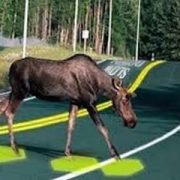?The Solar Road Revisited?. Somehow this modernized version of Bob Dylan?s epic folk album doesn?t quite ring true when couched in terms of our hyper accelerating 21st century technology. Perhaps a Millennial bard will improve on this in the future on iTunes, Pandora, and Beats, of course?
Yet, such a futuristic invention has already been created, is raising money through crowdfunding, and even landed a small Federal Highway Administration grant.
We live in an age of exploding technologies. So, when I find some that are especially interesting, offer a potential long term impact on the global economy, or present immediate investment opportunities, I am going to update you in this newsletter.
One common complaint I hear during my road shows is that we are moving into the future so fast, that it is getting increasingly hard to keep up. That is, unless you live within sight of Apple (AAPL), Google (GOOG), Twitter (TWTR), and Facebook (FB) headquarters, which I do. These companies all have venture capital arms, which fund many of these things.
Sandpoint, Idaho based engineers Julie and Scott Brusaw are the founders of Solar Roadways, a tiny engineering company that seeks to convert the American highway system from old fashioned asphalt and concrete to tempered glass and LED?s.
They have raised $2 million through the crowdsourcing website Indiegogo, which saw its amazing videos on the project go viral and attract 15 million views (https://www.indiegogo.com/projects/solar-roadways ).
Caution: conservatives may want to avert their eyes during all of the global warming, anti gasoline, and tree hugging references. But this stuff raises big bucks in California.
What can solar roads do? Obviously, the green hexagonal panels they are made of convert sunlight into electricity, heating roads so they can remain free of ice and snow all year. I could really use that up at Lake Tahoe.
Surplus power can be sold to local utilities to pay for it. Electric cars, like my Tesla Model S-1 (TSLA), can recharge their batteries just by parking on it, as my toothbrush already does in my bathroom.
You can program the LED?s to embed changeable road signs, borders, parking lots, and crosswalks. They can highlight crossing animals (200 deaths a year now in the US), or impending road obstructions.
They can even display layouts for every kind of sport (basketball, tennis, etc). The glass can be cast to give it a better grip than contemporary roads. Highway deaths would plunge, as would insurance costs.
Driving trucks on glass? The material is so strong that it can support the heaviest, or some 62 tons. My question, can handle steel caterpillar tractor treads used in road repair equipment?
Of course, it always comes down to cost with these new technologies, many of which remain pie in the sky forever. Estimates are that these roads cost 50%-300% more than existing ones. Large-scale construction would bring that down through economies of scale via mass production. The design is really quite simple.
The vision is big. It would probably cost over $1 trillion just to pave over the existing 48,000 miles of the interstate highway system. Tens of thousands of blue-collar jobs would be created. It all sounds like a massive public works project would be required, of Rooseveltian, CCC magnitude.
This just gives you a flavor of the incredibly interesting things going on here in the San Francisco Bay area, which I learn about on a daily basis. Check out the site, if only to see the future of start up funding.
You can contribute $5, or just buy a tote bag.






